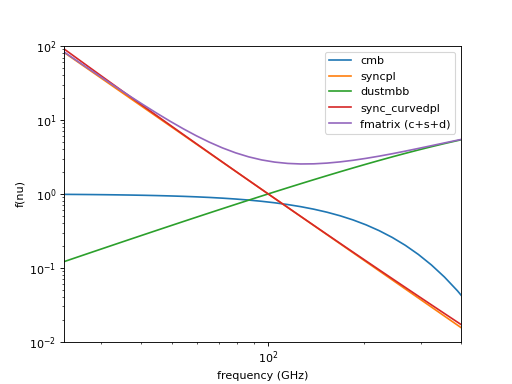SEDs (mesmer.seds)¶
This module contains the SEDs of the different physical components that are allowed in the likelihood. The list of currently allowed SEDs is:
These are referred ot by name when defining the FMatrix
object, which then composes the model as a linear sum of the
various components.
import matplotlib.pyplot as plt
import numpy as np
from mesmer.seds import *
freqs = np.logspace(1, 3)
c = cmb(freqs)
s = syncpl(freqs, 100., -3)
d = dustmbb(freqs, 100., 1.5, 20.)
sc = sync_curvedpl(freqs, 100, -3, 0.05)
fmatrix = FMatrix(['cmb', 'syncpl', 'dustmbb'])
params = {
'nu': freqs,
'nu_ref_s': 100.,
'nu_ref_d': 100.,
'beta_d': 1.5,
'T_d': 20.,
'beta_s': -3.
}
f = np.sum(fmatrix(**params), axis=0)
fig, ax = plt.subplots(1, 1)
ax.loglog(freqs, c, label='cmb')
ax.loglog(freqs, s, label='syncpl')
ax.loglog(freqs, d, label='dustmbb')
ax.loglog(freqs, sc, label='sync_curvedpl')
ax.loglog(freqs, f, label='fmatrix (c+s+d)')
ax.set_xlabel('frequency (GHz)')
ax.set_ylabel('f(nu)')
ax.set_xlim(23., 400.)
ax.set_ylim(1e-2, 1e2)
ax.legend()
plt.show()
(Source code, png, hires.png, pdf)

-
class
mesmer.seds.FMatrix(components)[source] [edit on github]¶ Bases:
objectClass to construct the foreground mixing matrix. This class models foreground SEDs of the different components of the sky model. This is an implementation of Equation (10) in 1608.00551, for a single set of spectral parameters.
Examples
>>> from mesmer.seds import FMatrix >>> fmatrix = FMatrix(['cmb', 'syncpl', 'dustmbb']) >>> pars = { ... 'nu': np.array([1, 100, 1000]), ... 'nu_ref_d' : 100., ... 'nu_ref_s' : 100., ... 'beta_s' : -3., ... 'beta_d' : 1.5, ... 'T_d' : 20., ... } >>> print(fmatrix(**pars).shape) (3, 3)
Once instantiated this function evaluates the component SEDs with which this class was instantiated.
As it is used in a variety of contexts, the
mesmer.seds.FMatrixcan be called in a variety of ways. It must ultimately be passed the arguments for all of the component functions. This is usually done through keyword arguments, however, the frequency can be passed as the only positional argument.- Parameters
- components: list(str)
List of function names. These functions, evaluated at a list of frequencies, will give the mixing matrix,
F.
- Returns
- ndarray
Array of shape (ncomps, nfreqs), representing the component SEDs evaluated for the requested frequencies.
-
mesmer.seds.cmb(nu: numpy.ndarray, *args, **kwargs) → numpy.ndarray[source] [edit on github]¶ Function to compute CMB SED, as a function of frequency.

- Parameters
- nu: float, or array_like(float)
Frequency in GHz,
 .
.
- Returns
- ndarray
CMB sed evaluated at frequency nu.
-
mesmer.seds.dustmbb(nu: numpy.ndarray, nu_ref_d: numpy.float32, beta_d: numpy.float32, T_d: numpy.float32, *args, **kwargs) → numpy.ndarray[source] [edit on github]¶ Function to compute modified blackbody dust SED, given by:

- Parameters
- nu: float or array_like(float)
Freuency at which to calculate SED,
 .
.- nu_ref_d: float
Reference frequency in GHz,
 .
.- beta_d: float
Power law index of dust opacity,
 .
.- T_d: float
Temperature of the dust,
 .
.
- Returns
- array_like(float)
SED of dust modified black body relative to reference frequency.
-
mesmer.seds.sync_curvedpl(nu: numpy.ndarray, nu_ref_s: numpy.float32, beta_s: numpy.float32, beta_c: numpy.float32, *args, **kwargs) → numpy.ndarray[source] [edit on github]¶ Function to compute curved synchrotron power law SED, given by:

- Parameters
- nu: float, or array_like(float)
Frequency in GHz,
 .
.- nu_ref_s: float
Reference frequency in GHz,
 .
.- beta_s: float
Power law index in RJ units,
 .
.- beta_c: float
Power law index curvature,
 .
.
- Returns
- array_like(float)
Synchroton SED relative to reference frequency.
-
mesmer.seds.syncpl(nu: numpy.ndarray, nu_ref_s: numpy.float32, beta_s: numpy.float32, *args, **kwargs) → numpy.ndarray[source] [edit on github]¶ Function to compute synchrotron power law SED, given by:

- Parameters
- nu: float, or array_like(float)
Frequency in GHz,
 .
.- nu_ref_s: float
Reference frequency in GHz,
 .
.- beta_s: float
Power law index in RJ units,
 .
.
- Returns
- array_like(float)
Synchroton SED relative to reference frequency.